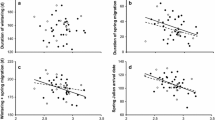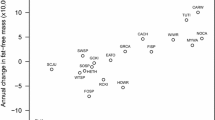Abstract
Body size is influenced by various environmental and genetic factors. The migratory locust, Locusta migratoria L., exhibits phase polyphenism in which nymphs change body coloration and adult body dimensions undergo specific changes in response to different population densities experienced during nymphal development. In this study, I collected adults of the migratory locust L. migratoria in solitarious (low-density) populations in central Japan over 16 years to determine how adult body size changed with years and how stable their body dimensions were. Four size parameters including head width (C), hind femur length (F), forewing length (E) and total body length (TBL) were highly correlated with each other. None of these parameters correlated with years except for E with a marginally significant correlation. None of these parameters showed a significant correlation with mean annual temperatures. The classical morphometric ratios, F/C and E/F, which are often used to separate different phases, showed no significant differences among years, suggesting that they may serve as reliable phase indicators for solitarious populations. The sexual size dimorphism (SSD) was confirmed and consistently larger variances in adult body size were observed in females than in males. When the mean values of the two sexes in different years were plotted, no significant correlation was observed in any of the body size parameters including C, F and E, indicating that the two sexes varied these parameters independently. The present data may provide a basis to analyze body size changes in relation to global climate changes in the future.




Similar content being viewed by others
References
Blackburn TM, Gaston K (2001) Linking patterns in macroecology. J Anim Ecol 70:338–352
Ciplak B, Sirin D, Taylan MS, Kaya S (2008) Altitudinal size clines, species richness and population density: case studies in Orthoptera. J Orthop Res 17:157–163
Dirsh VM (1951) A new biometrical phase character in locusts. Nature 167:281–282
Dirsh VM (1953) Morphometrical studies on phases of the desert locust (Schistocerca gregaria Forskål). Anti-Locust Bull 1:1–34
Farrow R, Colless DH (1980) Analysis of the interrelationships of geographical races of Locusta migratoria (Linnaeus) (Orthoptera: Acrididae), by numerical taxonomy, with special reference to sub-speciation in the tropics and affinities of the Australian race. Acrida 9:77–99
Hakomori T, Tanaka S (1992) Genetic control of diapause and other developmental traits of Japanese strains of the migratory locust Locusta migratoria L.: univoltine vs. biovoltine. Jpn J Entomol 60:319–328
Halsch CA, Shapiro AM, Fordyce JA, Nice CC, Thorne JH, Waetjen DP, Forister ML (2021) Insects and recent climate change. Proc Nat Acad Sci USA 118(2):e2002543117
Hochkirch A, Gröning J (2008) Sexual size dimorphism in Orthoptera (sens, str.)–a review. J Orthop Res 17:189–196
Hoste B, Simpson SJ, Tanaka S, Zhu D-H, De Loof A, Breuer M (2002) Effects of [His7]-corazonin on the phase state of isolated-reared (solitarious) desert locusts, Schistocerca gregaria. J Insect Physiol 48:891–990
Japan Meteorological Agency (2021). Retrieved from https://www.jma.go.jp/jma/index.html. Accessed 1 June 2021
Kiritani K, Yukawa J (2010) Effects of global warming on insects. Zenkoku Noson Kyoiku Kyokai Publishing, Tokyo (In Japanese)
Masaki S (1967) Geographic variation and climatic adaptation in a field cricket Orthoptera: Gryllidae. Evolution 21:725–741
Masaki S (1978) Seasonal and latitudinal adaptation in the life cycles of crickets. In: Dingle H (ed) Evolution of insect migration and diapause. Springer-Verlag, New York, pp 72–100
Masaki S (1987) Cricket Life Cycles. Evol Biol 21:349–423
Matsuda N, Tanaka K, Watari Y, Shintani Y, Goto SG, Nisimura T, Izumi Y, Numata H (2018) Northward expansion of the bivoltine life cycle of the cricket over the last four decades. Glob Change Biol. https://doi.org/10.1111/gcb.14436
Musolin DL, Tougou D, Fujisaki K (2010) Too hot to handle? Phenological and life-history responses to stimulated climate change of the southern green stink bug Nazara viridula (Heteroptera: Pentatomidae). Glob Change Biol 16:73–87
Nishide Y, Tanaka S (2013) Wing dimorphism in the migratory locust, Locusta migratoria: differentiation of wing morph and phase polyphenism. Entomol Sci 16:421–431. https://doi.org/10.1111/ens.12023
Otte D, Alexander RD (1983) The Australian crickets (Orthoptera: Gryllidae). Proc Acad Nat Sci Phila 22:1–477
Pener MP (1991) Locust phase polymorphism and its endocrine relations. Adv Insect Physiol 23:1–79
Pener MP, Simpson SJ (2009) Locust phase polyphenism: an update. Adv Insect Physiol 36:1–272
Peters RH (1983) The ecological implications of body size. Cambridge University Press, Cambridge
R Development Core Team (2018). https://cran.r-project.org/doc/contrib/manuals-jp/R-admin-jp.v15.pdf
Sugahara R, Tanaka S, Jouraku A, Shiotsuki T (2016) Functional characterization of the corazonin-encoding gene in phase polyphenism of the migratory locust, Locusta migratoria (Orthoptera: Acrididae). Appl Entomol Zool 51:225–232
Sugahara R, Tanaka S, Shiotsuki T (2017) RNAi-mediated knockdown of SPOOK reduces ecdysteroid titers and causes precocious metamorphosis in the desert locust Schistocerca gregaria. Dev Biol 429:7180
Tanaka H (1982) The migratory locust, Tocusta migratoria L. (Orthoptera: Acridicae), in Japan. I. Experiment on crowding effect. Appl Entomol Zool 17:467–476
Tanaka S (1994) Diapause as a pivotal factor for latitudinal and seasonal adaptation in Locusta migratoria in Japan. In: Danks HV (ed) Insect life-cycle polymorphism. Kluwer Academic Publishers, Netherlands, pp 173–190
Tanaka S (2006) Corazonin and locust phase polyphenism. Appl Entomol Zool 41:179–193
Tanaka S, Nishide Y (2012) First record of the occurrence and genetics of a short-winged morph in the migratory locust, Locusta migratoria (Orthoptera: Acrididae). J Orthop Res 21:169–174
Tanaka S, Zhu D-H, Hoste B, Breuer M (2002) The dark-color inducing neuropeptide, [His7]-corazonin, causes a shift in morphometric characteristics towards the gregarious phase in isolated-reared (solitarious) Locusta migratoria. J Insect Physiol 48:1065–1074
Uvarov B (1966) Grasshoppers and locusts: a handbook of general acridology. Vol. 1. Anatomy, physiology, development, phase polymorphism, introduction to taxonomy. Cambridge University Press
Uvarov B (1977) Grasshoppers and locusts: a handbook of general acridology. Vol 2. Behaviour, ecology, biogeography, population dynamics. London Centre for Overseas Pest Research
Whitman DW (2008) The significance of body size in the Orthoptera: a review. J Orthop Res 17:117–134
Whitman DW, Vincent S (2008) Body size in Orthoptera, preface. J Orthop Res 17:113–114
Yamagishi M, Tanaka S (2009) Overwintering biology and morphological characteristics of the migratory locust, Locusta migratoria after outbreaks on Iheya Island, Japan. Appl Ent Zool 44:165–174
Acknowledgements
The author thanks Dr. Shigeki Kishi for statistical assistance. Two anonymous reviewers improved the manuscript greatly.
Author information
Authors and Affiliations
Corresponding author
Additional information
Publisher's Note
Springer Nature remains neutral with regard to jurisdictional claims in published maps and institutional affiliations.
Supplementary Information
Below is the link to the electronic supplementary material.
Rights and permissions
About this article
Cite this article
Tanaka, S. Long-term monitoring of body size and morphometric ratios in the migratory locust, Locusta migratoria (Orthoptera: Acrididae). Appl Entomol Zool 57, 45–53 (2022). https://doi.org/10.1007/s13355-021-00760-8
Received:
Accepted:
Published:
Issue Date:
DOI: https://doi.org/10.1007/s13355-021-00760-8




